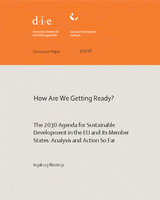How are we getting ready? The 2030 Agenda for Sustainable Development in the EU and its Member States: analysis and action so far
Niestroy, IngeborgDiscussion Paper 9/2016
Bonn: German Development Institute / Deutsches Institut für Entwicklungspolitik (DIE)
ISBN: 978-3-88985-688-3
Price: 6 €
On 1 January 2016, the 2030 Agenda and its 17 Sustainable Development Goals (SDGs) entered into force. Historically unique is its universality: it is to be implemented in all countries, high-, middle- and low-income alike. This paper explores how the EU and its Member States are getting ready for the implementation of the 2030 Agenda and takes stock of the activities undertaken so far. With an analysis of existing ‘gap analyses’, it points to areas in which the EU and its Member States are facing specific challenges, where the need for action is comparably large in domestic and external policies and/or where there are significant knock-on effects. It argues that the translation of the universal SDGs into a national and regional/EU context should be pursued in three parallel tracks: domestic (domestic policies with domestic impacts); domestic-external (domestic policies with external impacts); external (external policies with external impacts), taking into account feedback loops and impacts of global megatrends. The system of SDGs provides a suitable framework to tackle Europe’s key challenges in a comprehensive and strategic way, and to get on the required transformative path. A nexus approach is most appropriate for getting a grip on the interlinkages, synergies and trade-offs, for facilitating communication and improving integration. For the same end, horizontal and vertical policy coordination needs to be reinvigorated. This requires the establishment and maintenance of governance structures to overcome the traditional silo approach, both at EU- and at Member State-level.
With respect to policy areas, the strongest overlap of the gap analyses considered in this paper lies in SDG 12 Sustainable Consumption and Production, with Target 12.3 on food waste underlined, and SDG 8 Economy and Employment, with an emphasis on Target 8.4 resource efficiency. Policy areas next to these are: SDG 9 Infrastructure and Investment and its linkages with five other SDGs; SDG 10 Inequality, linked to four other SDGs; and SDG 2 Food and Agriculture in connection with three other SDGs.

